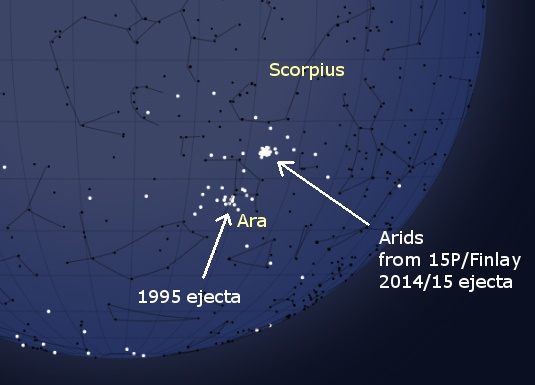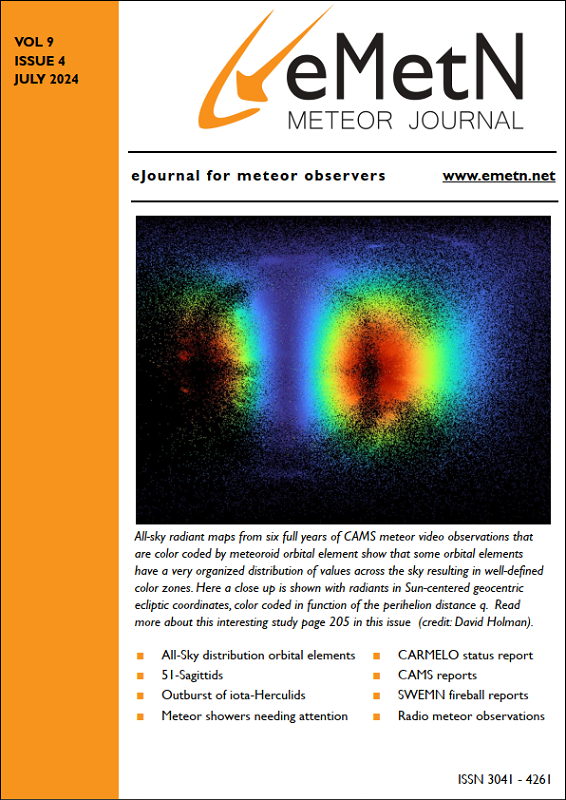By P. Jenniskens, S. Heathcote, E. Jehin, T. Abbott, M. Towner, T. Hanke, W. Cooney, T. Cooper and D. Lauretta
Abstract: The predicted Arid meteor shower outburst on October 6/7, 2021, caused by Earth encountering the debris ejected by comet 15P/Finlay during its activity outbursts in 2014 and 2015, did materialize. The 2014 outburst dust was documented by CAMS low-light video networks in Chile. The observed activity was higher than that during the 1995-dust trail crossing, suggesting that the cometary activity did have an influence on the density of the 2014 dust trail.
Introduction
Models of meteoroid stream formation and evolution predicted that debris from comet 15P/Finlay would move into Earth’s path in 2021, possibly creating a number of meteor shower outbursts associated with its returns to perihelion of 1988, 1995, 2008 and 2014/15 (Jenniskens, 2006; Maslov, 2009; Sato, 2009; Ye et al., 2015; Vaubaillon et al. 2020). The first set of outbursts were detected by the CAMS low-light video meteor orbit survey project during September 27–30, 2021 (Jenniskens et al., 2021), and by the SAAMER meteor orbit radar in Argentina (Bruzzone et al., 2021).
The second set of outbursts were expected on October 6-7, 2021, when Earth was to cross the debris ejected in 2008 and 2014/15. Especially the latter was of interest, as Ye et al. (2015) pointed out that the comet had two activity outbursts (also see Ishiguro et al., 2016), an outburst in 2014 that could cause a peak around 00:34-01:09h UT on Oct. 7, and an outburst in 2015 that could cause a peak about two hours earlier around 21:59-22:33 UT on Oct 6. These outbursts could have increased the dust trail density by a factor of 10-20 (Ye et al., 2021). After correction for this, zenith hourly rates as high as 30-100 (M. Sato) and 600-1100 (Ye) meteors per hour were expected.

Figure 1 – The radiants caused by 2014 and 2015 comet activity outburst ejecta in cams data from October 7, 2021, compared to the radiants of the 1995 ejecta from September 29 (overlaid).
CAMS detection of the 2014 dust trail
The CAMS video-based meteoroid orbit survey networks in Chile, Texas, Namibia and Australia detected this predicted Arid meteor shower outburst caused by Earth encountering the debris ejected by comet 15P/Finlay during its activity outbursts in 2014 and 2015. The night started out partially cloudy in Chile, with the first meteor detected at 23:21 UTC on Oct. 6. In partial clear skies, and based on the initial automatic reduction of data, a total of 19 Arids were triangulated by CAMS Chile (with networks operated by J. Rojas, J. Vilaza, and T. Abbott), 6 by CAMS Namibia (network operated by T. Hanke, E. Fahl and R. van Wyk) , 6 by CAMS Texas (W. Cooney, D. Selle, F. Cyrway, and J. Brewer), and 2 by CAMS Australia (M. Towner, C. Redford and L. Toms) during 2021 Oct. 6 11:04 and Oct. 7 04:10 UTC (c.f., http://cams.seti.org/FDL/ for dates of 2021 Oct. 7), corresponding to the solar longitude range 193.12 to 193.83 deg. (Equinox J2000.0).
Centered on solar longitude 193.68 ± 0.17 deg. (Oct. 7 00:41 UTC), these meteors radiated from a median geocentric radiant at R.A. = 256.8 ± 0.8, Decl. = -48.3 ± 0.6 deg., with geocentric speed Vg = 10.5 ± 0.3 km/s, slightly north-west from the 1995-dust ejecta radiant (Figure 1), but still in the constellation of Ara. Median orbital elements are a = 3.36 AU, q = 0.991 ± 0.002 AU, e = 0.705 ± 0.120, i = 6.7 ± 1.3 deg., Peri. = 348.3 ± 1.8 deg., and Node = 13.69 ± 0.17 deg. The predicted radiant was at R.A. = 256 deg., Decl. = -48 deg., and Vg = 10.7 km/s (Vaubaillon et al., 2020; Ye et al., 2021), in good agreement. Most meteors were faint. The magnitude distribution index was 4.2 +/- 0.6. Visual observer T. Cooper, Astronomical Society of Southern Africa, described two +1 and +2 Arids as: “Both very slow, noticeably orange, and sparkling appearance.”
First impression of other reported observations
The outburst was also detected by radio forward meteor scatter observations, summarized by H. Sugimoto and H. Ogawa of The International Project for Radio Meteor Observations. Results show enhanced rates from solar longitude 193.50 to 193.75 deg., peaking at 193.7 deg., corresponding to Oct. 7d 01h UTC (c.f. https://iprmo.org/flash/arids-2021.html). Their preliminary Zenith Hourly Rate is about 80/h. This is in line with predictions by Sato (in Ye et al., 2021).
Visual observer P. Vera of the University of La Serena, in an observing campaign led by J. Vaubaillon of I.M.C.C.E., reported seeing 35 meteors from the constellation Ara between 00:28 and 01:30 UT from El Sauce observatory near La Serena in cloudy skies ((c.f. https://www.imcce.fr/recherche/campagnes-observations/meteors/2021arids). This may well be in agreement with the radio MS reported ZHR.
The University of Colorado SkiYMET meteor radar at McMurdo Sound in Antarctica detected a significant increase in the radar reflection count peaking around 23h UT October 6 (c.f., https://ccar.colorado.edu/meteors/meteors). The slightly earlier peak time is perhaps because of the 2015 cometary outburst having been more rich in small particles.
In conclusion, it appears that the cometary outbursts did significantly enhance the dust density in the dust trail of comet 15P/Finlay. A more detailed analysis will be required to translate the observed dust densities and particle size distributions into better understanding the mass loss observed in 15P/Finlay cometary imaging in 2014 and 2015.
References
Bruzzone J. S., Janches D., Weryk R., Hormaechea J. L. (2021). “Arid meteors 2021”. CBET 5046, 2021 October 1, Daniel W. E. Green, editor.
Ishiguro M., Kuroda D., Hanayama H., et al. (2016). “2014-2015 multiple outbursts of 15P/Finlay.” Astron. J. 152, 169–183.
Jenniskens P. (2006). “Meteor Showers and their Parent Comets”. Cambridge University Press, Cambridge, UK, 790 pp (Table 6c).
Jenniskens P., Cooper T., Lauretta D. (2021). “Arid meteors 2021”. CBET 5046, 2021 October 1, Daniel W. E. Green, editor.
Maslov M. (2009). “Finlayids 1901–2001: Activity predictions”. Website: http://feraj.ru/Radiants/Predictions/ 1901-2100eng/Finlayids1901-2100predeng.html (last accessed 2021-09-30).
Sato M. (2009) In a deleted post on a yahoo group message board. (see: Ye et al. 2015).
Vaubaillon J. , Egal A. , Desmars J., Baillie K. (2020). “Meteor shower output caused by comet 15P/Finlay”. WGN, Journal of the International Meteor Organization, 48, 29-35.
Ye Q.-Z., Brown P. G., Bell C., Gao X., Masek M., Hui M.-T. (2015). “Bangs and meteors from the quiet comet 15P/Finlay.” Astrophys. J., 814, 79–88.
Ye Q.-Z., Vaubaillon J., Sato M., Maslov M. (2021). “Arid meteors 2021”. CBET 5049, 2021 October 4, Daniel W. E. Green, editor.


